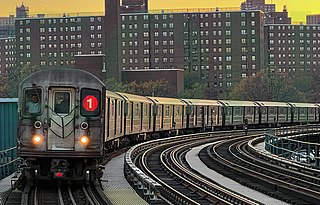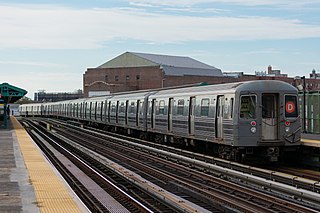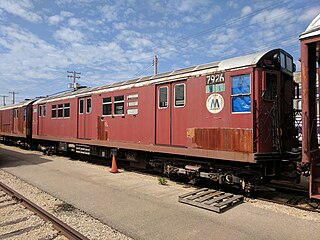
The C Eighth Avenue Local is a 19-mile-long (31 km) rapid transit service in the B Division of the New York City Subway. Its route emblem, or "bullet", is blue since it is a part of the IND Eighth Avenue Line in Manhattan.

The 7 Flushing Local and <7> Flushing Express are two rapid transit services in the A Division of the New York City Subway, providing local and express services along the full length of the IRT Flushing Line. Their route emblems, or "bullets", are colored purple, since they serve the Flushing Line.

The R142 is the first mass-produced model class of the newest generation or new technology (NTT) A Division cars for the New York City Subway. It was built by Bombardier Transportation in La Pocatière, Quebec, Canada and Barre, Vermont, U.S. with final assembly performed at Plattsburgh, New York, from 1999 to 2003. There are 880 cars numbered 6301–7180 and another 150 cars numbered 1101–1250, for a total of 1,030 cars, all arranged as five-car sets. Together with the R142As, they replaced the Redbird trains, including the R26, R28, R29, R33, R33S, and R36.

The R46 is a New York City Subway car model that was built by the Pullman Standard Company from 1975 to 1978 for the IND/BMT B Division. They replaced all remaining R1–9 fleet cars and General Electric-powered R16s, and some R10s. The R46 order initially consisted of 754 single cars, each 75 feet (23 m) long, and was the largest single order of passenger cars in United States railroad history at the point of the fleet's completion. The R46 was the second order of 75-foot cars to be ordered for the New York City Subway, after the R44s.

The R44 is a New York City Subway car model built by the St. Louis Car Company from 1971 to 1973 for the B Division and the Staten Island Railway (SIR). The cars replaced many R1–9 series cars, and all remaining 1925 Standard Steel built SIRTOA ME-1 trains, providing Staten Island with a new fleet of railcars. The R44 fleet originally consisted of 352 cars, of which 56 remain in service, all on the Staten Island Railway.

The R62 is a New York City Subway car model built between 1983 and 1985 by Kawasaki Heavy Industries in Kobe, Japan, for the A Division. A total of 325 cars were built, originally as single units. When the reliability of the fleet improved, they were converted to five-car sets. The cars replaced the remaining R12s, R14s, and R15s, which were all retired by the end of 1984.

The New York City Subway is a large rapid transit system and has a large fleet of electric multiple unit rolling stock. As of September 2024, the New York City Subway has 6712 cars on the roster.

The F and <F> Queens Boulevard Express/Sixth Avenue Local are two rapid transit services in the B Division of the New York City Subway. Their route bullets are colored orange, since they use and are part of the IND Sixth Avenue Line in Manhattan.

The R62A is a New York City Subway car model built between 1984 and 1987 by Bombardier Transportation for the A Division. The cars were built in La Pocatière, Quebec, with final assembly done in Auburn, New York and Barre, Vermont, under a license from Kawasaki Heavy Industries, manufacturer of the previous R62 order. A total of 825 cars were built, arranged as sets of three, four, or five cars per set. The cars replaced the remaining R17s, R21s, and R22s, which were all retired by early 1988.

The R68 is a B Division New York City Subway car order consisting of 425 cars built by the Westinghouse-Amrail Company, a joint venture of Westinghouse, ANF Industrie, Jeumont Schneider, and Alsthom. The cars were built in France from 1986 to 1988 and shipped through New York Harbor. Of the cars in the fleet, 416 are arranged in four-car sets while the other nine are single cars.

The R143 is a class of New Technology Train subway cars built by Kawasaki Rail Car Company for the New York City Subway's B Division. Delivered between 2001 and 2003, the cars displaced R40s and R42s that operated on the L service in conjunction with the BMT Canarsie Line's signal system being automated.

The R28 was a New York City Subway car model built by American Car and Foundry (ACF) from 1960 to 1961. The cars were a "follow-up" or supplemental stock for the A Division's R26s and closely resemble them. The average car cost per R28 was $114,495. A total of 100 cars were built, arranged in married pairs.

Most trains on the New York City Subway are manually operated. As of 2022, the system currently uses automatic block signaling, with fixed wayside signals and automatic train stops. Many portions of the signaling system were installed between the 1930s and 1960s. Because of the age of the subway system, many replacement parts are unavailable from signaling suppliers and must be custom-built for the New York City Transit Authority, which operates the subway. Additionally, some subway lines have reached their train capacity limits and cannot operate extra trains in the current system.

The R160 is a class of New Technology Train subway cars built for the New York City Subway's B Division. Entering service between 2006 and 2010, they replaced all R38, R40, and NYCT-operated R44 cars, and most R32 and R42 cars. The R160s are very similar to the earlier R143s and later R179s. The biggest difference between the R160 and R143 is the Flexible Information and Notice Display (FIND) system on the R160s in place of static LED maps on the R143s and all A-Division New Technology fleet.

The R179 is a class of 318 New Technology Train subway cars built by Bombardier Transportation for the New York City Subway's B Division. Entering service between 2017 and 2020, the cars replaced all remaining R32s and R42s.

The R188 is a class of new technology (NTT) New York City Subway cars built by Kawasaki Heavy Industries for the A Division. The fleet entered service in 2013, displacing the mid-1980s–era R62A cars that operated on the 7 and <7> services, in conjunction with the automation of the IRT Flushing Line's signal system with communications-based train control (CBTC). The R188 order also expanded the 7's fleet as part of the 7 Subway Extension, which opened in 2015.

The R211 is a class of New Technology Train (NTT) subway cars built for the New York City Transit Authority. Being built by Kawasaki Railcar Manufacturing for the B Division of the New York City Subway and for the Staten Island Railway (SIR), they will replace two aging subway car models: all R44 cars on the SIR, plus all R46 and some R68 subway cars. The order is split into three parts: R211A and R211T cars for the subway and R211S cars for the SIR. The R211Ts employ open gangways between cars, allowing passengers to see and walk through the entire length of the train – a feature not present on the subway's other rolling stock.

New Technology Train (NTT) is the collective term for the modern passenger fleet of the New York City Subway that has entered service since the turn of the 21st century. This includes the current R142, R142A, R143, R160, R179, R188 and R211 models, along with the planned R262 and R268 models. Two prototypes, the R110A and R110B, were used to test the features that would be found on all NTT trains today.

The R262 is a proposed New Technology Train-series subway car for the New York City Subway. It is expected to replace the current R62 and R62A rolling stock, which are used on the subway's A Division and were built in the mid-1980s.




















